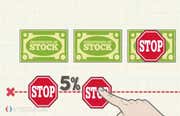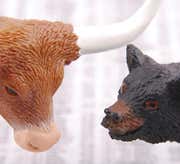In this section, we discuss the practical matter of going about buying and selling shares of stock. Individuals typically buy and sell shares by using a licensed brokerage firm or broker who makes the actual trade. Historically, stockbrokers were hired only by wealthy individuals and families, but today a wide range of stock brokerages exist for all price ranges. So-called “full-service” brokers offer a suite of research, opinion, and expert advice and can offer a personal relationship between the broker and the client. For more budget conscious clients, discount brokerages exist that offer a much more bare-bones service offering, in some cases simply executing purchases and sales. Over the past two decades, electronic trading has grown significantly, with many online brokerages offering both research and opinion as well as trades at low prices, some asking as little as $5 or less per trade in commission. (See also: How To Choose Your First Stock Broker.)
Regardless of the type of brokerage used, the mechanics of buying or selling shares is fairly uniform. First, a stock quote is obtained. In the early days of stock exchanges, price information was transmitted via tickertape – a long ribbon of paper that printed basic data via telegraph wire. That is why today we still refer to stock quotes as the ticker.
A stock quote carries a lot of information including the current bid and offer (sometimes called the ask) prices as well as the last price that traded. The bid is the highest price that somebody in the market is willing to pay at a given time, while the offer is the lowest price that somebody is willing to sell. If you are interested in buying shares, you will make a bid, and if you want to sell an offer. When the price of a bid and offer coincide, a trade is effected.
In addition to this price information, data on trading volume (number of shares traded) is often included. Stock quotes obtained online are often real-time quotes that confer second-by-second details, and online quotes also often include charts and interactive tools. Stocks are quoted by their ticker symbol, represented by between one and four capital letters, which are often loosely representative of the company name. For example the ticker symbol for Microsoft Corp. is MSFT, Caterpillar Inc. is CAT, and Apple Inc. is AAPL.
Market Orders and Limit Orders
Next, the type of trade has to be determined. A market order is simply an order that instructs the broker (or online trading platform) to buy or sell shares at the best available price. If you wanted to buy 100 shares of AAPL at market, and the quote shows: Bid: $139.80 (100), Offer: $140.00 (50), Last: $139.95 (250). This tells us that the last trade was 250 shares at $139.50 and it indicates 50 shares are offered at $140.00. Suppose another 200 are offered at $140.05. Your market order would buy the 50 shares at $140.00 and then purchase 50 more at the next best price at $140.05.
A market order does not guarantee the price you will get, but it does guarantee that you will get the number of shares that you want, in this case 100. When an order is completed, it is said to be filled. A market order is most often used in cases where the buyer or seller is most concerned with filling the size of the order and not concerned with the price. A limit order specifies the price at which you want to trade. For example, you may specify that you want to buy AAPL for $140.00 but no more, in which case you would buy the 50 shares offered at $140.00 and then wait for some other seller to come down to your price. Until that happens, the new quote would be Bid: $140.00 (50), Offer: $140.05 (200), Last: $140.00 (50).
A limit order can also be designated all-or-none (AON), meaning that you won’t agree to buy your shares unless you can get all 100 that you want. If the original limit order in this example were AON, you would not buy the 50 that are offered until another 50 came along. Limit orders are used by those who are primarily concerned with the price they want to receive, but they are not guaranteed that the size of their order will be filled. Price versus getting filled on the size of your order are the primary trade-offs between market and limit orders.
Stop Orders
Stop orders are contingent on a certain price level being attained to activate the trade. With a stop order, your trade will be executed only when the security you want to buy or sell reaches a particular price (the stop price). Once the stock has reached this price, a stop order essentially becomes a market order and is filled. For instance, if you own stock ABC, which currently trades at $20, and you place a stop order to sell it at $15, your order will only be filled once stock ABC drops below $15. Also known as a stop-loss order, this allows you to limit your losses.
This type of order can also be used to guarantee profits. For example, assume that you bought stock XYZ at $10 per share and now the stock is trading at $20 per share. Placing a stop order at $15 will guarantee profits of approximately $5 per share, depending on how quickly the market order can be filled. Stop orders are particularly advantageous to investors who are unable to monitor their stocks for a period of time, and brokerages may even set these stop orders for no charge.
One disadvantage of the stop order is that the order is not guaranteed to be filled at the preferred price the investor states. Once the stop order has been triggered, it turns into a market order, which is filled at the best possible price. This price may be lower than the price specified by the stop order. Moreover, investors must be conscientious about where they set a stop order. It may be unfavorable if it is activated by a short-term fluctuation in the stock's price. For example, if stock ABC is relatively volatile and fluctuates by 15% on a weekly basis, a stop-loss set at 10% below the current price may result in the order being triggered at an inopportune or premature time.
Other Kinds of Orders
Orders may also be tagged with instructions regarding how long an order is good for. An immediate-or-cancel (IOC) order is cancelled if the order isn’t executed right away. This is typically used in conjunction with a limit order. When an IOC order is combined with an AON order, it is designated fill-or-kill (FOK). A day order is a limit or stop order that is cancelled at the end of the trading day, and will not be active the next morning. A good-til-canceled (GTC) order is active until the instruction is given to cancel it, and may remain active for many days at a time or longer.
Margin Trading and Short Selling
In addition to the mechanics described above, many brokerages offer margin trading, allowing their customers to borrow money to buy shares in excess of the amount of cash in their account. Margin also allows for short selling, which is where a market participant borrows shares they do not own in order to sell them with the hope of buying them back in the future at a lower price. A short seller is betting that the price of a stock will go down, rather than up.
In addition to using a brokerage, there are two less common ways to own shares: dividend reinvestment plans (DRIPs) and direct investment plans (DIPs). DIPs are plans by which individual companies, for a minimal cost, allow shareholders to purchase stock directly from the company. DRIPs are where the dividends paid by shares are automatically used to purchase more of those shares (including fractions of a share).
Stocks Basics: Bulls, Bears & Market Sentiment
-
 Investing
InvestingUnderstanding Market Orders And Limit Orders
A market order executes a transaction as quickly as possible at the present price. Immediacy is the main concern. A limit order is executed at or below a purchase or sale price. Price is the ... -
 Investing
InvestingStop Loss Order Strategy
A stop loss order is an order placed with a broker to sell a stock immediately if it drops to a certain price. It's a common way for investors to protect themselves from the possibility of a ... -
 Trading
TradingUse Stops To Protect Yourself From Market Loss
Master these simple risk management strategies to protect your portfolio or trading account from large losses. -
 Trading
TradingThe Basics of the Bid-Ask Spread
The bid-ask spread is the difference between the bid price and ask price prices for a particular security. -
 Trading
TradingThe Stop-Loss Order - Make Sure You Use It
The stop-loss order is a simple but powerful investing tool. Find out how you can use it to help you implement your stock-investment strategy.



